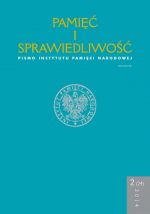Polityka władz komunistycznych wobec twórców kultury w latach 1945–1989
The Policy of the Communist Authorities towards Writers and Artists between 1945 and 1989
Author(s): Sebastian LigarskiSubject(s): Politics / Political Sciences, History, Cultural history, Recent History (1900 till today), Post-War period (1950 - 1989)
Published by: Instytut Pamięci Narodowej
Keywords: culture; policy; authorities; Polish People’s Republic; 1945–1989; writers
Summary/Abstract: The policy of the communist authorities towards writers and artists in the 1945 to 1989 period can be divided into several stages. The first lasted from the end of 1944 to November 1947. The second stage lasted from November 1947 until the end of 1949, when socialist realism was forcibly introduced into all areas of cultural life. The third stage ended at the beginning of 1955, when one could observe a weakening of the authorities (accused of violations of the socialist rule of law). The whole year 1955 and the turn of 1956/1957 is referred to as the “thaw” period. During Władysław Gomułka’s era (October 1956 – December 1970), the attitude adopted by the authorities towards artists remained mostly unchanged. It manifested itself as an ideological offensive and repression of any emerging signs of resistance in that community. When Edward Gierek was in power as the First Secretary of the Central Committee of the Polish United Workers’ Party (1970–1980), the policy towards writers and artists evolved in two stages. The first (1971–1976) was characterized by liberalism and pragmatism, as part of a regime’s legitimization strategy. During the second stage, lasting from February 1976 to August 1980, preventive and repressive elements began to prevail in the position taken towards artists, who increasingly voiced opposition towards the authorities. Opposition was to be quashed by more stringent censorship, numerous searches, interrogationof artists and harassment. In 1980 and 1981, the authorities concentrated on ensuring that the managing bodies of the artist/writer associations had the right political credentials, although with no effect. They supported artists with communist party affiliations and unsuccessfully tried to attract the neutral centre and to exploit it. During the martial law period, the authorities adopted a repressive policy towards artists, but they failed to put an end to their boycott of public institutions. The attempt to use artists to legitimize the activities of the authorities in the perestroika period was only partially successful. Finally, the cultural policy of the authorities was put aside altogether after the political changes of 1989.
Journal: Pamięć i Sprawiedliwość.
- Issue Year: 24/2014
- Issue No: 2
- Page Range: 51-73
- Page Count: 23
- Language: Polish

